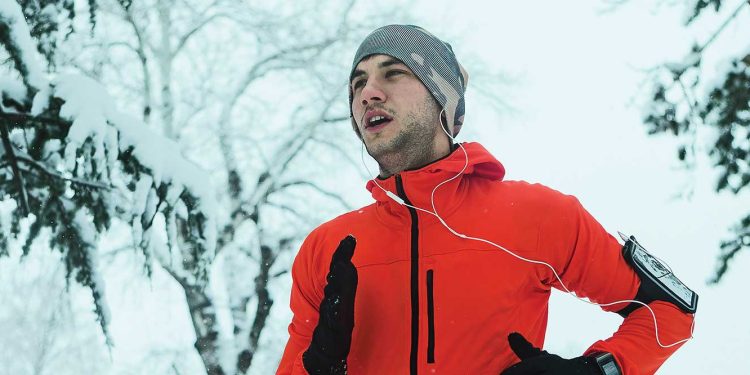For many, nothing beats running exterior. You get to really feel the solar in your face and breathe recent air whereas getting a superb exercise. Plus, there are countless issues to have a look at – distractions that make it simpler to fulfill your training objectives because you’re not centered in your legs and lungs.
But as the times get shorter and colder, and the snowflakes start to fall, it’s a superb time to consider the way you’ll hold your fitness degree up throughout the winter months.
Running in winter can enhance your likelihood of muscle, bone and ligament injuries to your knees, ft, ankles, groins, legs, palms and wrists. But it’s attainable for runners to sprint by the snow and nonetheless keep protected.
Read on to study why running injuries are extra frequent in winter, plus tips on tips on how to keep away from them.
Why running injuries are extra frequent in winter
You can get running injuries anytime of the yr – however winter will increase the probability of frequent running injuries corresponding to muscle and tendon strains and tears. There are a number of causes for this.
Winter situations trigger falls and accidents
In winter, the bottom may be icy and uneven from thick snow. These situations make it extra probably you’ll slip and fall on the laborious, frozen floor. Plus, you’re extra prone to run when there’s poor visibility since there are fewer daylight and climate situations like blizzards and freezing rain.
Changes to your running kind enhance stress in your body
You run in another way in winter. To hold from slipping and falling, you’re prone to shorten your stride. It’s additionally pure to lean again barely with every step as a strategy to floor your footing and hold from slipping.
These modifications in running kind trigger you to rely extra on stabilizer muscular tissues corresponding to these in the higher thighs and pelvis. These stabilizer muscular tissues enable you to hold your steadiness. But in the event that they haven’t been conditioned to resist the stress of winter running, they’re extra prone to get harm.
Cold muscular tissues usually tend to get sprained or torn
Cold temperatures could make muscular tissues tighter, affecting how nicely they work throughout exercise. Warming up inside is necessary throughout chilly winter months as a result of it helps your body extra simply deal with the chilly temperatures – we get into that extra beneath.
Freezing temperatures may be harmful
Cold temperatures are unhealthy for muscular tissues and uncovered pores and skin. But what temp is simply too chilly to run? To some extent (pun meant), it’s private. Many runners keep away from running in temperatures beneath freezing (32 levels Fahrenheit) as a result of they’ve issue respiratory or really feel numbness in their toes or different extremities.
Runners with bronchial asthma, heart problems, diabetes, Raynaud’s syndrome and low body fats could also be notably delicate to running in chilly climate. The American College of Sports Medicine says that runners must be extraordinarily cautious when running exterior in windchill temperatures colder than minus 18 levels Fahrenheit.
It’s straightforward to push your self too laborious when running
You can run quicker in cooler temperatures, so it’s simpler to overexert your self. Although uneven terrain will probably make it tough so that you can max out your pace, overexertion can result in tearing or overusing your muscular tissues, tendons and ligaments.
Though winter running may be harmful, you don’t have to hold up your running sneakers till the spring thaw. There are good causes to proceed (and even start) a running routine throughout the winter.
- Winter running may be extra snug – When you exercise in winter, you don’t get as scorching. And by dressing in layers, you’ll be capable to higher management your body temperature.
- Winter running makes you decelerate – In life, we’re at all times speeding from one process to a different. In winter, the situations sometimes power runners to decelerate. You can benefit from the surroundings (and all these stunning snowflakes) whereas nonetheless getting a exercise that will get your coronary heart pumping.
- Winter running could make you’re feeling much less self-conscious – If you’re simply beginning a running routine, it’s straightforward to really feel self-conscious. In winter, there aren’t as many individuals on running paths which implies there are fewer eyes on you. This could make it simpler to construct up your strength and endurance with out worrying about what different individuals might imagine.
9 methods to stop winter running injuries
With the correct amount of preparation and care, it’s attainable to take pleasure in the advantages of winter running with out hurting your self. Here are 9 methods to stop running injuries.
1. Choose the appropriate gear: What to put on running in winter
How do individuals survive running in the winter? An enormous half is choosing the gear that’s going to maintain you heat, dry and visual on darkish, snowy mornings and evenings.
It may be difficult realizing how a lot to put on because you’ll get hotter as you run. A superb rule of thumb is to decorate as if it’s 15-20 levels hotter than it truly is. You shall be a bit chilly beginning out, however try to be comfortably heat after about 10 minutes.
If your running gear is simply too heat, you may get scorching and sweaty, which may make you colder. When sweat cools or freezes, it may well enhance your likelihood of hypothermia.
Of course, the chilly isn’t the one hazard for winter runners. Running when it’s darkish or snowy could make it more durable for drivers to see you, so be sure that to put on reflective gadgets or LED lights.
Winter running gear in your legs and higher body
When gearing up for out of doors winter running, you’ll need to costume in layers – that approach you’ll be able to take away gadgets while you start to really feel too heat. But you’ll probably want fewer layers in your legs in comparison with your higher body.
- Base layer – For each your legs and your core, you’ll need to start with a base layer of fabric that wicks moisture. Silk, wool and artificial materials are good choices – simply skip cotton because it loses its insulating properties as soon as it turns into moist with sweat. A mock turtleneck is a superb alternative in your higher body. Below the waist, select thermal running pants with a water-proof outer layer and a brushed interior layer.
- Outer layer – Look for a skinny, windproof jacket designed for chilly climate. These jackets often have extra insulation in your core. For hotter winter days, you could not want an outer layer in your legs. But as soon as temperatures drop beneath 10 levels Fahrenheit, it’s greatest to throw a pair of windproof monitor pants on over your running tights.
Winter running sneakers and socks
Many winter running injuries are attributable to slipping. So discovering the appropriate footwear must be a precedence. When shopping for running sneakers, you’ll need to select heat sneakers with traction.
- Trail sneakers – Even for those who’re a highway runner, it’s greatest to make use of path sneakers all through the winter since they’ve higher grip, bolstered uppers and higher insulation. Some path sneakers actually have a waterproof barrier to maintain your ft and ankles dry regardless of how slushy it will get exterior.
- Traction cleat gadget – For added safety in opposition to icy situations, slip a traction cleat gadget over your running sneakers. There are choices with coils, spikes or each – and you will discover them at shoe shops or on-line. But not all traction cleat gadgets will work for all sneakers, so be sure you do your analysis earlier than shopping for.
- Winter running socks – You’ll need insulated running socks that wick moisture and aren’t too cumbersome. Also, search for ones that cowl your ankles. For added ankle safety, contemplate carrying running gaiters over your tights.
Winter running equipment
You’ll want winter running equipment like hats and gloves to remain heat and forestall frostbite, windburn and chapped pores and skin.
- Gloves for running – Look for skinny gloves that wick moisture.
- Winter hat or headband – The kind of safety you want relies on the temperature exterior. If it’s above freezing, a light-weight hat is ok. If it’s beneath freezing, go for a hat or a scarf manufactured from wool or thick fleece. And when it will get actually chilly (beneath 10 levels Fahrenheit) swap to a full ski masks. If you’re nonetheless chilly, layer on a neck gaiter. Good supplies for hats and headbands embrace wool and fleece.
2. Watch the temperature and climate
With the right running gear and a hearty structure, you could possibly run exterior a lot of the winter. But throughout Midwest winters, it’s attainable for the temperature to drop to ranges which are merely unsafe for running.
Pay attention to the climate forecast and attempt to plan your runs for when there must be sunshine and better temperatures. But since meteorologists aren’t at all times right, be sure you examine the climate earlier than heading out and, if crucial, change your plan.
It’s additionally necessary to keep away from unsafe situations corresponding to blizzards and freezing rain. If you start to surprise, “Should I be running in this?” you in all probability shouldn’t. Head again residence and end your exercise inside.
3. Warm up in a heat location
Your body at all times works higher after a warm-up, however it’s particularly necessary for cold-weather running because the excessive chilly tightens muscular tissues and will increase the prospect of harm. Before heading out, heat up for no less than 5 minutes. Good choices embrace lunges, jogging in place and foam rolling.
4. Pace your self
It’s not truthful to your body to count on it to match the pace and distance information you set earlier in the yr. Even for those who’re going slower, your body will probably be working simply as laborious. Worry much less about your distance and pace. Focus as an alternative in your coronary heart fee and the length of your exercise.
5. Keep your body fueled and hydrated
There’s a decrease likelihood of dehydration in the winter, however it nonetheless occurs. Sweating is much less apparent in winter, and it’s straightforward to neglect that you simply’ve misplaced fluids that should be changed. But with out correct hydration and nourishment, your body gained’t work very nicely, and also you’re extra prone to get injured.
So, be sure that to down a giant glass of water and a small snack earlier than you head out. When you come back, deal with changing misplaced fluids. Eating a post-run snack that’s a steadiness of protein and carbs can even assist your body refuel and recuperate.
6. Be ready for winter running injuries
We sincerely hope that you simply don’t get harm this winter. But it’s necessary to know what you’ll do if an accident occurs. It’s greatest to run with a buddy in winter – or no less than let individuals know the place you’re going and while you’ll return. And in fact, deliver your cellphone so you’ll be able to name for assist for those who want it.
7. Don’t cease on the end line: Post-run routine
Sudden modifications in temperatures aren’t good in your muscular tissues. In the identical approach {that a} warm-up is tremendous necessary in winter, so is a calm down.
It may be powerful to seek out the motivation to do a lot stretching after a future. But if the selection is between some stretches or no stretches, even a number of are higher than none.
Aim for 2-4 exercises, stretches and therapeutic massage methods centered on an space that tends to get tight, sore or injured. Incorporating strength training as a part of your post-workout routine will help you construct up extra strength that can assist you energy by the winter.
8. Pay attention to your body
You’ll probably have extra soreness in completely different locations, corresponding to your higher thighs and hips. Make certain you don’t overexert your self and, as an alternative, run at a sluggish and comfy tempo a number of instances per week. If you’ve gotten ache that doesn’t go away or your body feels run down and achy, it is likely to be time to take a break from running and take a look at one thing completely different.
9. Have a backup plan
If you reside in the Midwest, it’s a protected wager that there shall be instances when out of doors running isn’t a protected possibility. But as an alternative of skipping or delaying your exercise, why not strive one thing new?
Winter is usually a nice time to increase your exercise horizons, construct up strength and suppleness, and injury-proof the areas of your body extra prone to get harm. Areas to discover embrace:
- Other methods to run – Get on a treadmill, strive indoor running tracks or do brief sprints in your own home
- Cross training – Swimming, stationary biking and yoga are choices to extend your fitness, endurance and suppleness
- Strength training – Building muscle in your legs will help put together your body for the impression of winter running in your body.
When to see a bodily therapist or physician after a running harm
If you harm your self whereas running exterior, don’t attempt to energy by – you probably have ache or swelling, it shouldn’t be ignored.
You ought to head to orthopedic pressing care in case you are experiencing extreme ache or having issue shifting your injured body half, or it’s apparent that’s one thing is damaged.
Other running pains can often be handled at residence with R.I.C.E remedy (which stands for relaxation, icing, compression and elevation) for 24-48 hours. But in case your harm doesn’t get higher in a few days, make a bodily remedy appointment.
Stay energetic. Stay heat. Stay protected
Winter running does have some dangers. But taking the winter off from exercise isn’t advisable since your muscular tissues will not be prepared when the hotter climate rolls round and also you’re training for a spring marathon.
If it looks like you’re continuously battling aches, pains or injuries, it could be time for a unique resolution. The Running Program at TRIA will help you handle present injuries and forestall future ones. We’ll have a look at your running kind and develop a running plan that can assist you heal after harm.
With some planning, you need to be capable to take pleasure in winter running with out injuries – or discover alternative actions that can assist hold your running muscular tissues robust, all yr lengthy.



















Discussion about this post